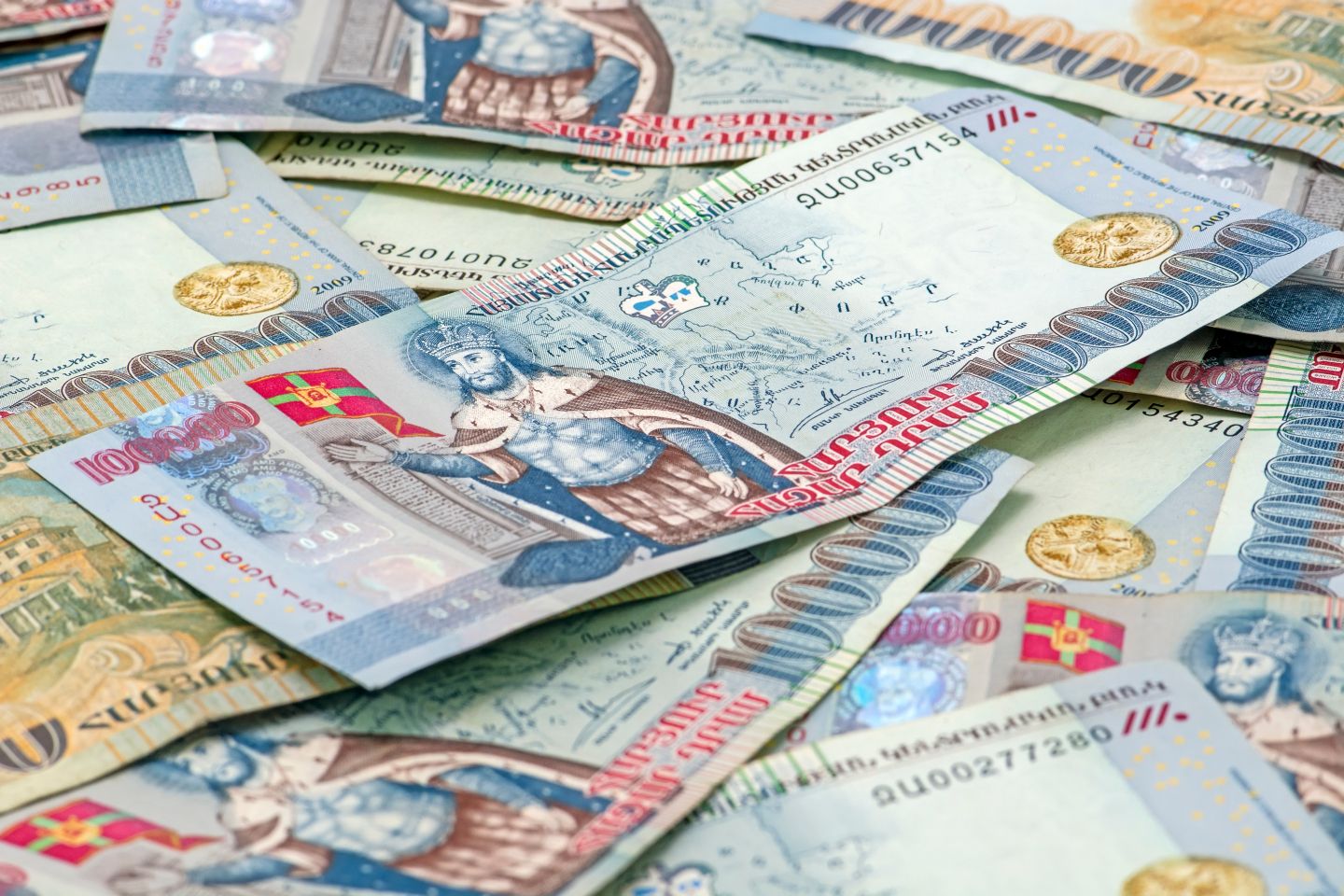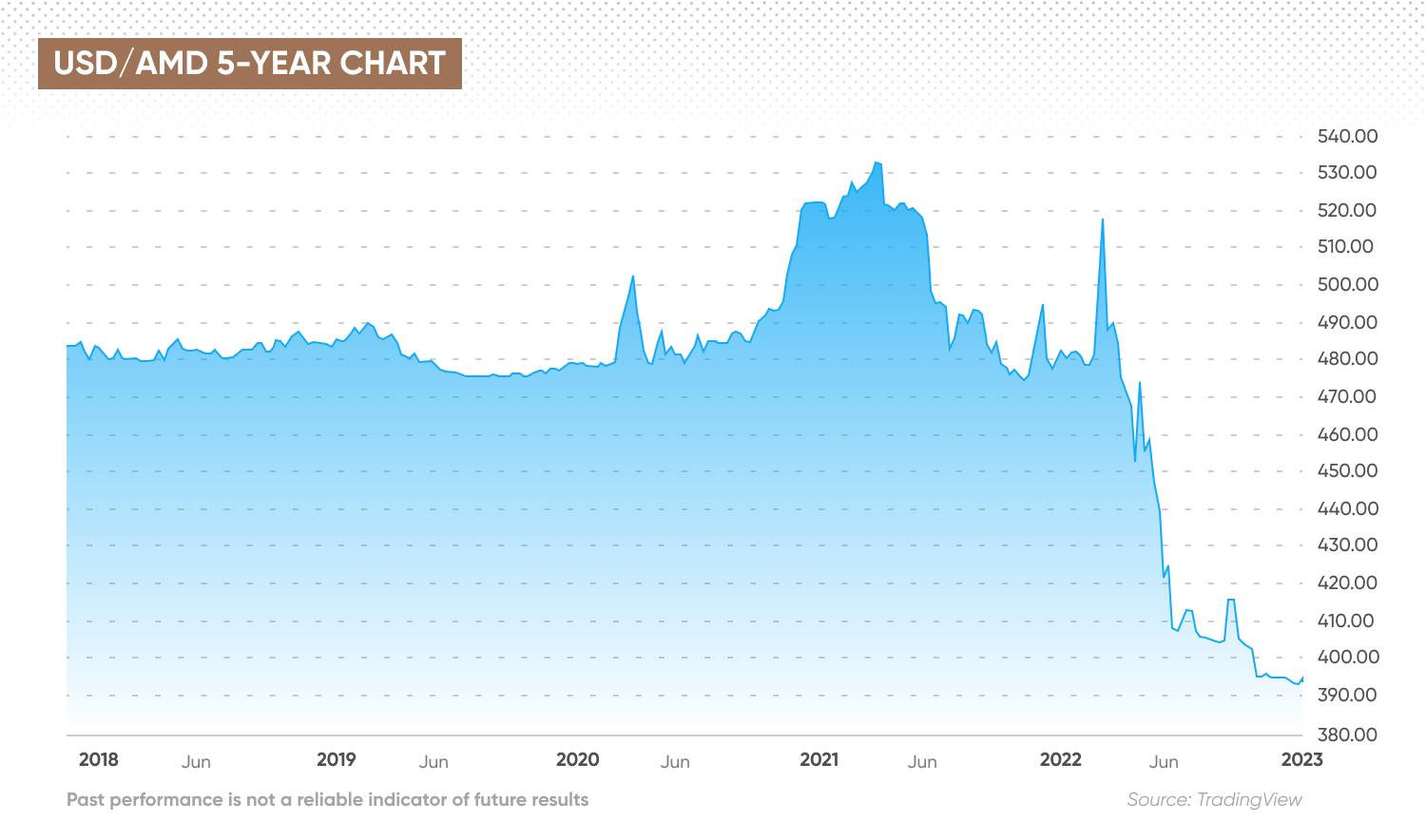Armenian Dram Forecast: Will AMD continue to outperform against the US dollar and euro?
We look at the latest analyst Armenian dram forecast round-up.
The Armenian dram (AMD) was one of the world’s best performing currencies against the US dollar (USD) in the past year. It, like many currencies of countries neighbouring Russia, soared in value since March after Russia’s invasion of Ukraine.
Russian citizens moving to neighbouring countries such as Armenia since the start of the war have contributed to a spike in foreign exchange (forex) transfers and demand for consumer products. Forex inflows into Armenia totalled $2.8bn in the first 10 months of 2022, according to Bloomberg, lifting the dram 22% against the US dollar.
What are the main drivers for the value of the Armenian dram and what is the outlook for the currency in 2023?
What drives the Armenian dram?
The Armenian dram is the official currency of Armenia and the neighbouring unrecognised Republic of Artsakh. The dram was introduced in 1993 after Armenia’s independence from the Soviet Union (USSR) in 1991 and the collapse of a currency union among the newly independent nations. The Central Bank of Armenia was established in March 1993. The dram was introduced in November of that year. The exchange rate at that time was 404 AMD to one USD.
The value of the dram fluctuates based on the country’s economic growth, external trade and central bank monetary policy, as well as Armenia’s foreign currency reserves.
Armenia's largest exports include copper and ferroalloys, energy, beverages, fruit and vegetables. Its top five export partners are Russia, Germany, Iran, Bulgaria and the Netherlands.
Dram strength defies expectations

The US dollar, the global reserve currency, strengthened in 2022 against a basket of currencies in response to geopolitical tensions such as the Russia-Ukraine conflict and aggressive interest rate hikes by the Federal Reserve (Fed) to tame inflation. But the appreciation in the dram was stronger, driving the USD/AMD rate lower.
The USD/AMD exchange rate began falling sharply in early 2021, as prices for copper climbed, increasing the value of Armenia’s copper exports, and money transfers from abroad increased in line with a rise in tourism after Covid-19 lockdowns.
The USD/AMD pair fell from above 525 in January 2021 to around 480 at the start of 2022. The rate stabilised around 480-485 until March, when it began to fall. The pair was trading around 407 by June and moved below the 400 mark in October. It has since been trading between 390 and 400, hovering around 394 at the time of writing on 3 January.
The dram has similarly made strong gains against the euro (EUR), with the EUR/AMD pair dropping from around 634 at the start of 2021 to 540 by early 2022 and 397 by September. The pair was around 416.50 at the time of writing.
Russian citizens relocating to Armenia to avoid the war in Ukraine have brought billions in savings into the country, driving up the value of the dram. The sharp currency appreciation and strong economic growth are contrary to economists’ expectations at the start of the conflict. Analysts had expected Russia’s neighbours to face economic turmoil because of disruption in their largest trading partner.
Analysts at research agency Fitch Solutions wrote in May: “We believe that higher inflationary pressures that are partly emerging from supply shocks caused by the war in Ukraine, alongside tighter credit conditions, will weigh on domestic demand in 2022… between March and April, Armenia’s information technology industry - which makes up 6.3% of GDP and is one of the country’s fastest growing sectors - saw a doubling in the number of individuals employed. Much of this is thought to be driven by younger skilled workers leaving Russia.
However, the analysts added: “An influx of Russian migrants fleeing the war will provide a boost to the retail and services sector more broadly, which is why we do not expect growth to collapse in Armenia.”
Instead of declining from 5.7% in 2021, Armenia’s gross domestic product (GDP) climbed in 2022, rising from 8.6% in the first quarter and 13% in the second quarter to 14.8% in the third quarter, data from economic analysis provider Trading Economics shows.
While a stronger currency reduces the cost of imported goods, the strong dram has put pressure on Armenia’s exporters, such as the IT sector, which exports software and services.
"The losses and risks of the IT sector against the background of the devaluation of the dollar are becoming more prominent,” the Mantashyants Entrepreneurs Union said in November.
What is the Armenian dram forecast for the year ahead? Will the currency strengthen or decline against the US dollar and euro?
Armenian dram forecast: More strength for AMD ahead?
At the time of writing, the AMD forecast from analysts and algorithm-based services indicated that the dram could remain volatile against other currencies over the long term.
USD/AMD forecast
The USD/AMD forecast from Wallet Investor’s algorithm predicted that the pair could fall to 374.303 by the end of this year and 355.692 by the end of 2024. The site’s Armenian dram forecast for 2025 projected that the pair could reach 336.55 by the end of the year. The USD/AMD rate could fall below 300 in 2027 and trade at 298.507 by January 2028.
Gov Capital’s AMD prediction showed that the US dollar could weaken further to 387.992 against the dram by the end of this year.
However, the Armenian dram forecast for 2023 from Trading Economics suggested that the USD/AMD pair could rise from 398.08 at the end of the first quarter to 416.89 in 12 months’ time, based on global macro models and analysts’ expectations.
The long-term AMD prediction from Useforecast projected that the USD/AMD pair could stabilise around 404 for most of 2023 and then edge down to 401.63 by the end of 2025 and 395.37 by the end of 2030.
EUR/AMD forecast
Wallet Investor’s Armenian dram forecast against the euro estimated that the EUR/AMD pair could drop below 400 this year to 392.311 by the end of December. The AMD forecast showed that the rate could then fall to 363.60 by the end of 2024, 334.515 by the end of 2025 and 276.414 by January 2028.
The euro to Armenian dram forecast from Trading Economics also indicated that the rate could move lower, albeit at a slower pace, from moving down from 419.077 at the end of this quarter and 417.782 in one year.
But for the longer term, the Armenian dram forecast for 2030 from Useforecast estimated that the euro could rise against the dram from the 418-421 range in 2023 to 443.116 by the end of the decade.
The bottom line
If you are looking for an Armenian dram forecast for your forex trading, it’s important to keep in mind that the high volatility of currency markets makes it difficult for analysts and algorithm-based forecasters to come up with accurate predictions, especially for the long term. As such, they can and do get their predictions wrong.
You should always do your own research. Look at the latest market trends, news, technical and fundamental analysis, and expert opinion before making any investment decision. Keep in mind that past performance is no guarantee of future returns. And never trade with money you cannot afford to lose.
Stay up to date with the major forex pairs using our currency strength meter.
FAQs
Has the Armenian dram been going up or down?
The Armenian dram has strengthened against the US dollar and euro on soaring foreign currency reserves since the start of the Russia-Ukraine conflict as well as rising commodity exports.
Will the Armenian dram get stronger in 2023?
The direction of the dram in 2023 could depend on Armenia’s foreign currency inflows and the impact of the war in Ukraine as well as its overall economic growth, among other factors.
Is it a good time to buy Armenian dram?
Whether it is a good time for you to buy the dram is a personal decision only you can make depending on your risk tolerance, portfolio composition and trading approach. Always do your own research. And never trade with money you cannot afford to lose.